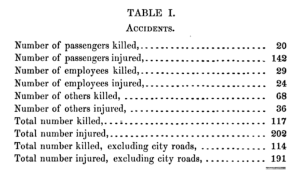 From the 1858 New York State Engineer and Surveyor’s report on the many railroads operating in the state, we find this interesting tabulation of the human cost of running the rails in that year.
From the 1858 New York State Engineer and Surveyor’s report on the many railroads operating in the state, we find this interesting tabulation of the human cost of running the rails in that year.
The number of passengers killed for the year was 20; 142 were injured. Railroad employees: 29 killed, 24 injured. Others (presumably those within some proximity of the tracks at the wrong time): 68 killed, 36 injured.
Pretty dry statistics, but have no fear: State Engineer Van Rensselaer Richmond found a way to put that passenger mortality statistic into perspective:
Dividing 373,159,179, the mileage of passengers, by 20, the number of passengers killed, we find that only one passenger was killed for 18,657,959 miles of travel. To travel this distance it would require more than 106 years, moving incessantly at the rate of 20 miles per hour.
So there you have it. As the human lifespan is considerably less than 106 years, and on average we travel at much less than 20 miles per hour (and certainly not incessantly), there’s actually no chance we will ever die by rail. Or, if by chance you were to take that trip, you’d simply need to get off a mile short of 18,657,959 and you’d be fine.

Leave a Reply